高中英语词类与句子成分 课件(共22张PPT)
文档属性
| 名称 | 高中英语词类与句子成分 课件(共22张PPT) |  | |
| 格式 | zip | ||
| 文件大小 | 164.9KB | ||
| 资源类型 | 教案 | ||
| 版本资源 | 通用版 | ||
| 科目 | 英语 | ||
| 更新时间 | 2020-09-05 08:47:37 | ||
图片预览

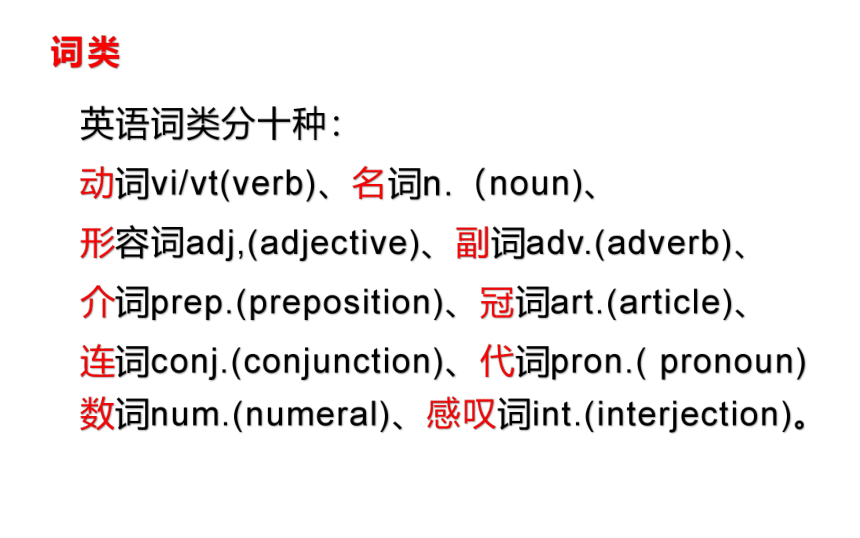
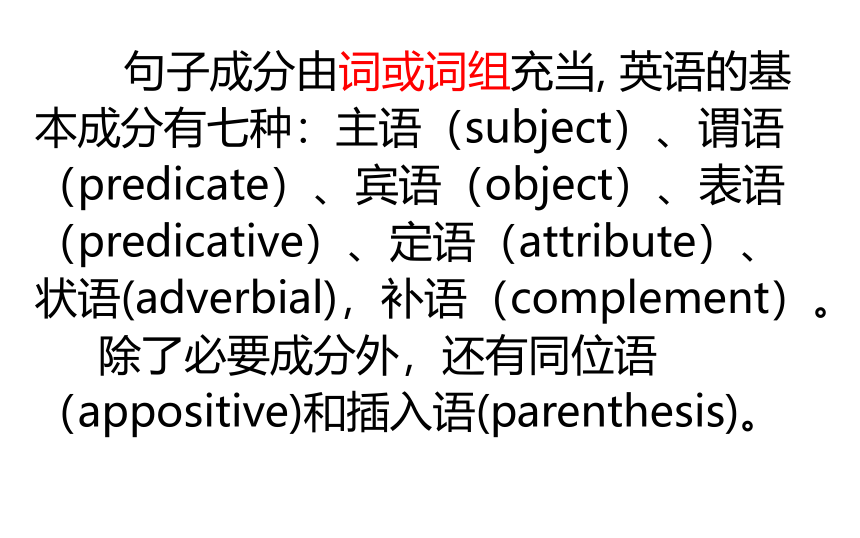
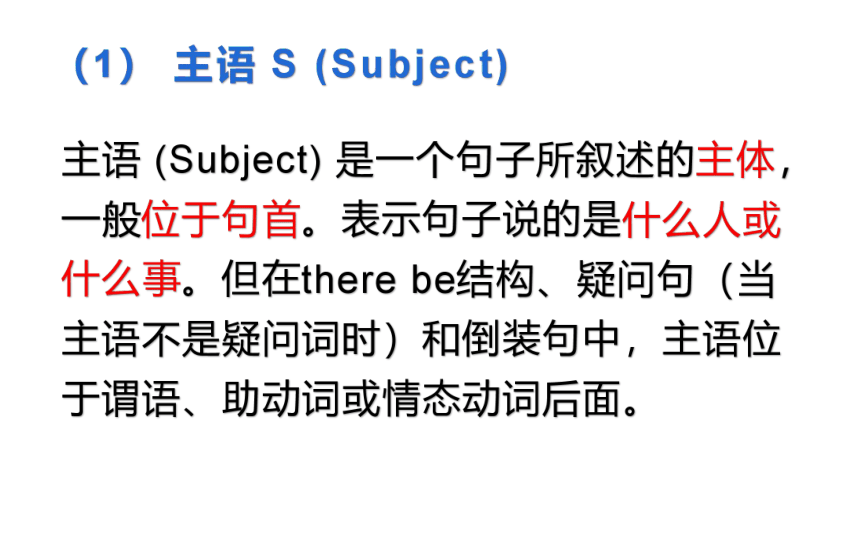
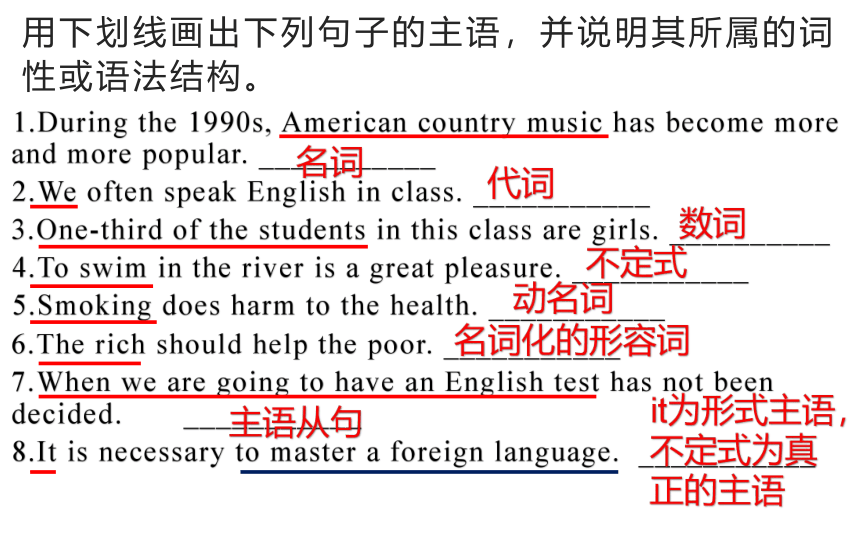

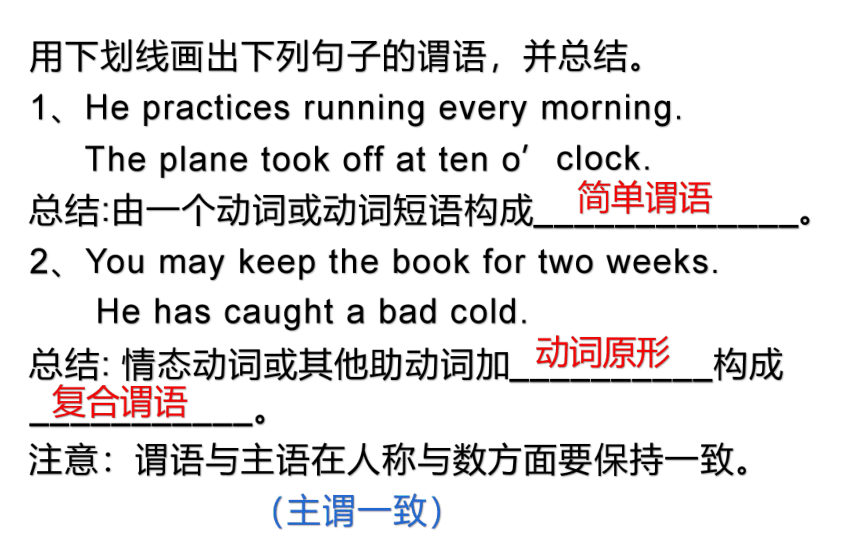
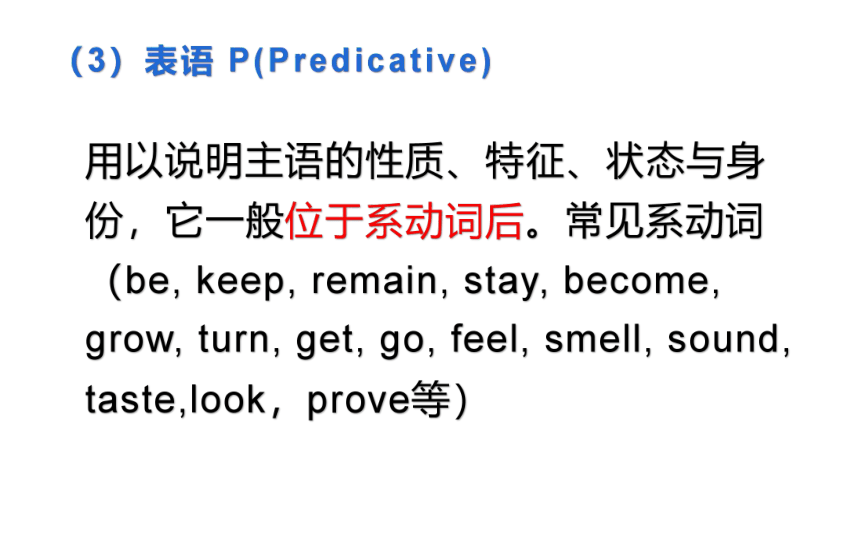
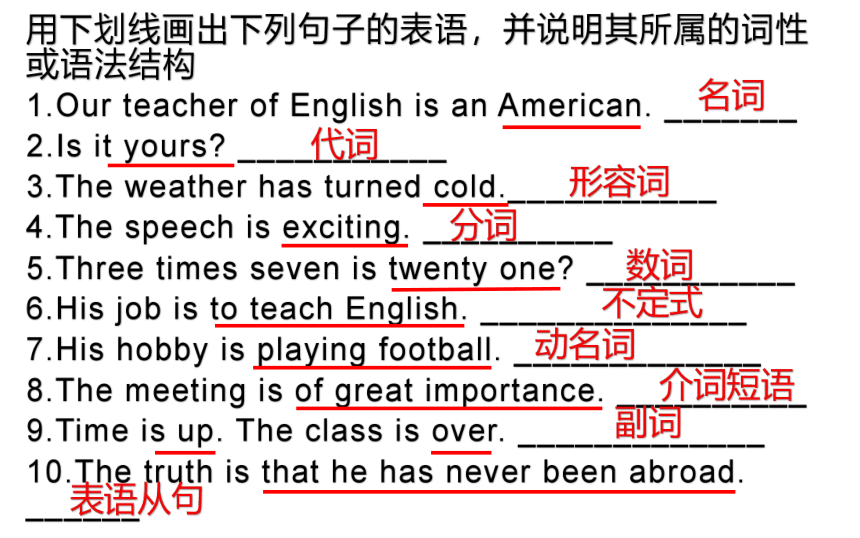
文档简介
(共22张PPT)
词类与句子成分
英语词类分十种:
动词vi/vt(verb)、名词n.(noun)、
形容词adj,(adjective)、副词adv.(adverb)、
介词prep.(preposition)、冠词art.(article)、
连词conj.(conjunction)、代词pron.(
pronoun)数词num.(numeral)、感叹词int.(interjection)。
词类
句子成分由词或词组充当,
英语的基本成分有七种:主语(subject)、谓语(predicate)、宾语(object)、表语(predicative)、定语(attribute)、状语(adverbial),补语(complement)。
除了必要成分外,还有同位语(appositive)和插入语(parenthesis)。
主语
(Subject)
是一个句子所叙述的主体,一般位于句首。表示句子说的是什么人或什么事。但在there
be结构、疑问句(当主语不是疑问词时)和倒装句中,主语位于谓语、助动词或情态动词后面。
(1)
主语
S
(Subject)
1.During
the
1990s,
American
country
music
has
become
more
and
more
popular.
___________
2.We
often
speak
English
in
class.
___________
3.One-third
of
the
students
in
this
class
are
girls.
__________
4.To
swim
in
the
river
is
a
great
pleasure.
___________
5.Smoking
does
harm
to
the
health.
___________
6.The
rich
should
help
the
poor.
___________
7.When
we
are
going
to
have
an
English
test
has
not
been
decided.
___________
8.It
is
necessary
to
master
a
foreign
language.
___________
用下划线画出下列句子的主语,并说明其所属的词性或语法结构。
名词
代词
数词
不定式
动名词
名词化的形容词
主语从句
it为形式主语,
不定式为真正的主语
谓语说明主语所做的动作或具有的特征和状态。动词在句中作谓语,一般放在主语之后。
(2)
谓语
V
(Predicate)
用下划线画出下列句子的谓语,并总结。
1、He
practices
running
every
morning.
The
plane
took
off
at
ten
o’clock.
总结:由一个动词或动词短语构成_____________。
2、You
may
keep
the
book
for
two
weeks.
He
has
caught
a
bad
cold.
总结:
情态动词或其他助动词加__________构成___________。
注意:谓语与主语在人称与数方面要保持一致。
(主谓一致)
简单谓语
动词原形
复合谓语
用以说明主语的性质、特征、状态与身份,它一般位于系动词后。常见系动词(be,
keep,
remain,
stay,
become,
grow,
turn,
get,
go,
feel,
smell,
sound,
taste,look,prove等)
(3)表语
P(Predicative)
用下划线画出下列句子的表语,并说明其所属的词性或语法结构
1.Our
teacher
of
English
is
an
American.
_______
2.Is
it
yours?
___________
3.The
weather
has
turned
cold.___________
4.The
speech
is
exciting.
__________
5.Three
times
seven
is
twenty
one?
___________
6.His
job
is
to
teach
English.
______________
7.His
hobby
is
playing
football.
_____________
8.The
meeting
is
of
great
importance.
__________
9.Time
is
up.
The
class
is
over.
_____________
10.The
truth
is
that
he
has
never
been
abroad.
______
名词
代词
形容词
分词
数词
不定式
动名词
介词短语
副词
表语从句
注意:系动词(Linking
verb)用于连接主语和表语,说明主语的状态,性质特征和身份等。
1)状态系动词用来表示主语状态,只有be一词,例如:
He
is
a
teacher.
2)持续系动词用来表示主语继续或保持一种状况或态度,主要有keep,
remain,
stay,
stand,
例如:
He
always
keep
silent
at
meeting.?
3)感官系动词主要有feel,
smell,
sound,
taste,
look.
例如:
This
kind
of
cloth
feels
very
soft.
4)变化系动词表示主语变成什么样,主要有become,
grow,
turn,
fall,
get,
go,
come,
run.例如:
He
became
mad
after
that.??
除此之外,还有prove,
turn
out,
appear,
seem等。
The
rumor
proved
false.
His
plan
turned
out
a
success。
表示动作的对象或承受者,一般位于及物动词和介词后面。
(4)宾语
O(Object)
用下划线画出下列句子的宾语,并说明其所属的词性或语法结构
1.They
visited
an
exhibition
yesterday.
________
2.The
heavy
rain
prevented
me
from
coming
to
school
on
time.
________
3.How
many
dictionaries
do
you
have?
I
have
five.
___________
4.They
helped
the
old
with
their
housework
yesterday.
_____________
5.He
pretended
not
to
see
me.
__________
6.I
enjoy
listening
to
popular
music.
__________
7.I
think(that)he
is
fit
for
his
office.
_________
名词
代词,动名词
名词,数词
名词化形容词,名词
不定式
动名词
宾语从句
宾语种类:
1.双宾语(间接宾语O(人)+直接宾语O(物))
Lend
me
your
dictionary,
please.
He
gave
me
a
book
yesterday.
Buy
sth
for
sb
2.复合宾语(宾语O+宾补C)构成逻辑上的主谓关系
1)
They
elected
him
their
monitor.
名词
2)They
painted
their
boat
white.
形容词
3)Let
the
fresh
air
in.
介词
4)You
mustn't
force
him
to
lend
his
money
to
you.
不定式
5)We
saw
her
entering
the
room.
动名词
6)We
found
everything
in
the
lab
in
good
order.
介词短语
7)We
will
soon
make
our
city
what
your
city
is
now.
从句
修饰,限制,描述或补充说明名词或代词的词、短语或从句称为定语(Attribute)。在汉语中常用
“……的”表示。
(5)定语
(attribute)
用下划线画出下列句子的定语,并说明其所属的词性或语法结构
1.Guilin
is
a
beautiful
city.
_________
2.China
is
a
developing
country;
America
is
a
developed
country.
__________
3.There
are
thirty
women
teachers
in
our
school.______
4.His
rapid
progress
in
English
made
us
surprised._____
5.Our
monitor
is
always
the
first
to
enter
the
classroom.
____________
6.The
teaching
plan
for
next
term
has
been
worked
out.
____________
7.He
is
reading
an
article
about
how
to
learn
English.
____________
8.Farmers
who
saw
us
stared
at
us
as
if
we
are
walking
skeletons.
__________
形容词
分词
代词
不定式短语
名词
动名词
介词短语
定语从句
修饰动词、形容词、副词或整个句子,说明动作或状态特征的句子成分。从情况,时间,处所,方式,条件,对象,肯定,否定,范围和程度等方面对谓语中心进行修饰或限制。
(6)状语
(adverbial)
用下划线画出下列句子的状语,并说明其所属的词性或语法结构
1.Light
travels
most
quickly.
____________
2.He
has
lived
in
the
city
for
ten
years.
____________
3.He
is
proud
to
have
passed
the
national
college
entrance
examination.
____________
4.He
sat
there
,
reading
a
book.
_______________
5.Wait
a
minute.
___________
6.Once
you
begin,
you
must
continue.
_____________
副词或副词性的短语
介词短语
不定式(原因状语)
分词短语做伴随状语
名词
状语从句
9种状语种类如下:
1.
How
about
meeting
again
at
six?
时间
2.Last
night
she
didn’t
go
to
the
dance
party
because
of
the
rain.
原因
3.I
shall
go
there
if
it
doesn’t
rain.
条件
4.Mr
Smith
lives
on
the
third
floor.
地点
5.She
put
the
eggs
into
the
basket
with
great
care.
方式
5.
She
came
in
with
a
dictionary
in
her
hand.
伴随
6.In
order
to
catch
up
with
the
others,
I
must
work
harder.
目的
7.He
was
so
tired
that
he
fell
asleep
immediately.
结果
8.She
works
very
hard
though
she
is
old.
让步
9.I
am
taller
than
he
is.
比较
同位语(Appositive)对前面的名词或代词做进一步的解释,通常由名词、数词、代词或从句担任,如:
This
is
Mr.
Zhou,
our
headmaster.
We
students
should
study
hard.
We
all
are
students.
(7)同位语(Appositive)
插入语(Parenthesis)对一句话做一些附加的解释,通常有to
be
honest
,
I
think
(suppose,
believe---)等,如:
To
be
frank,
I
don’t
quite
agree
with
you.
(8)插入语(Parenthesis)
Thank
You!
词类与句子成分
英语词类分十种:
动词vi/vt(verb)、名词n.(noun)、
形容词adj,(adjective)、副词adv.(adverb)、
介词prep.(preposition)、冠词art.(article)、
连词conj.(conjunction)、代词pron.(
pronoun)数词num.(numeral)、感叹词int.(interjection)。
词类
句子成分由词或词组充当,
英语的基本成分有七种:主语(subject)、谓语(predicate)、宾语(object)、表语(predicative)、定语(attribute)、状语(adverbial),补语(complement)。
除了必要成分外,还有同位语(appositive)和插入语(parenthesis)。
主语
(Subject)
是一个句子所叙述的主体,一般位于句首。表示句子说的是什么人或什么事。但在there
be结构、疑问句(当主语不是疑问词时)和倒装句中,主语位于谓语、助动词或情态动词后面。
(1)
主语
S
(Subject)
1.During
the
1990s,
American
country
music
has
become
more
and
more
popular.
___________
2.We
often
speak
English
in
class.
___________
3.One-third
of
the
students
in
this
class
are
girls.
__________
4.To
swim
in
the
river
is
a
great
pleasure.
___________
5.Smoking
does
harm
to
the
health.
___________
6.The
rich
should
help
the
poor.
___________
7.When
we
are
going
to
have
an
English
test
has
not
been
decided.
___________
8.It
is
necessary
to
master
a
foreign
language.
___________
用下划线画出下列句子的主语,并说明其所属的词性或语法结构。
名词
代词
数词
不定式
动名词
名词化的形容词
主语从句
it为形式主语,
不定式为真正的主语
谓语说明主语所做的动作或具有的特征和状态。动词在句中作谓语,一般放在主语之后。
(2)
谓语
V
(Predicate)
用下划线画出下列句子的谓语,并总结。
1、He
practices
running
every
morning.
The
plane
took
off
at
ten
o’clock.
总结:由一个动词或动词短语构成_____________。
2、You
may
keep
the
book
for
two
weeks.
He
has
caught
a
bad
cold.
总结:
情态动词或其他助动词加__________构成___________。
注意:谓语与主语在人称与数方面要保持一致。
(主谓一致)
简单谓语
动词原形
复合谓语
用以说明主语的性质、特征、状态与身份,它一般位于系动词后。常见系动词(be,
keep,
remain,
stay,
become,
grow,
turn,
get,
go,
feel,
smell,
sound,
taste,look,prove等)
(3)表语
P(Predicative)
用下划线画出下列句子的表语,并说明其所属的词性或语法结构
1.Our
teacher
of
English
is
an
American.
_______
2.Is
it
yours?
___________
3.The
weather
has
turned
cold.___________
4.The
speech
is
exciting.
__________
5.Three
times
seven
is
twenty
one?
___________
6.His
job
is
to
teach
English.
______________
7.His
hobby
is
playing
football.
_____________
8.The
meeting
is
of
great
importance.
__________
9.Time
is
up.
The
class
is
over.
_____________
10.The
truth
is
that
he
has
never
been
abroad.
______
名词
代词
形容词
分词
数词
不定式
动名词
介词短语
副词
表语从句
注意:系动词(Linking
verb)用于连接主语和表语,说明主语的状态,性质特征和身份等。
1)状态系动词用来表示主语状态,只有be一词,例如:
He
is
a
teacher.
2)持续系动词用来表示主语继续或保持一种状况或态度,主要有keep,
remain,
stay,
stand,
例如:
He
always
keep
silent
at
meeting.?
3)感官系动词主要有feel,
smell,
sound,
taste,
look.
例如:
This
kind
of
cloth
feels
very
soft.
4)变化系动词表示主语变成什么样,主要有become,
grow,
turn,
fall,
get,
go,
come,
run.例如:
He
became
mad
after
that.??
除此之外,还有prove,
turn
out,
appear,
seem等。
The
rumor
proved
false.
His
plan
turned
out
a
success。
表示动作的对象或承受者,一般位于及物动词和介词后面。
(4)宾语
O(Object)
用下划线画出下列句子的宾语,并说明其所属的词性或语法结构
1.They
visited
an
exhibition
yesterday.
________
2.The
heavy
rain
prevented
me
from
coming
to
school
on
time.
________
3.How
many
dictionaries
do
you
have?
I
have
five.
___________
4.They
helped
the
old
with
their
housework
yesterday.
_____________
5.He
pretended
not
to
see
me.
__________
6.I
enjoy
listening
to
popular
music.
__________
7.I
think(that)he
is
fit
for
his
office.
_________
名词
代词,动名词
名词,数词
名词化形容词,名词
不定式
动名词
宾语从句
宾语种类:
1.双宾语(间接宾语O(人)+直接宾语O(物))
Lend
me
your
dictionary,
please.
He
gave
me
a
book
yesterday.
Buy
sth
for
sb
2.复合宾语(宾语O+宾补C)构成逻辑上的主谓关系
1)
They
elected
him
their
monitor.
名词
2)They
painted
their
boat
white.
形容词
3)Let
the
fresh
air
in.
介词
4)You
mustn't
force
him
to
lend
his
money
to
you.
不定式
5)We
saw
her
entering
the
room.
动名词
6)We
found
everything
in
the
lab
in
good
order.
介词短语
7)We
will
soon
make
our
city
what
your
city
is
now.
从句
修饰,限制,描述或补充说明名词或代词的词、短语或从句称为定语(Attribute)。在汉语中常用
“……的”表示。
(5)定语
(attribute)
用下划线画出下列句子的定语,并说明其所属的词性或语法结构
1.Guilin
is
a
beautiful
city.
_________
2.China
is
a
developing
country;
America
is
a
developed
country.
__________
3.There
are
thirty
women
teachers
in
our
school.______
4.His
rapid
progress
in
English
made
us
surprised._____
5.Our
monitor
is
always
the
first
to
enter
the
classroom.
____________
6.The
teaching
plan
for
next
term
has
been
worked
out.
____________
7.He
is
reading
an
article
about
how
to
learn
English.
____________
8.Farmers
who
saw
us
stared
at
us
as
if
we
are
walking
skeletons.
__________
形容词
分词
代词
不定式短语
名词
动名词
介词短语
定语从句
修饰动词、形容词、副词或整个句子,说明动作或状态特征的句子成分。从情况,时间,处所,方式,条件,对象,肯定,否定,范围和程度等方面对谓语中心进行修饰或限制。
(6)状语
(adverbial)
用下划线画出下列句子的状语,并说明其所属的词性或语法结构
1.Light
travels
most
quickly.
____________
2.He
has
lived
in
the
city
for
ten
years.
____________
3.He
is
proud
to
have
passed
the
national
college
entrance
examination.
____________
4.He
sat
there
,
reading
a
book.
_______________
5.Wait
a
minute.
___________
6.Once
you
begin,
you
must
continue.
_____________
副词或副词性的短语
介词短语
不定式(原因状语)
分词短语做伴随状语
名词
状语从句
9种状语种类如下:
1.
How
about
meeting
again
at
six?
时间
2.Last
night
she
didn’t
go
to
the
dance
party
because
of
the
rain.
原因
3.I
shall
go
there
if
it
doesn’t
rain.
条件
4.Mr
Smith
lives
on
the
third
floor.
地点
5.She
put
the
eggs
into
the
basket
with
great
care.
方式
5.
She
came
in
with
a
dictionary
in
her
hand.
伴随
6.In
order
to
catch
up
with
the
others,
I
must
work
harder.
目的
7.He
was
so
tired
that
he
fell
asleep
immediately.
结果
8.She
works
very
hard
though
she
is
old.
让步
9.I
am
taller
than
he
is.
比较
同位语(Appositive)对前面的名词或代词做进一步的解释,通常由名词、数词、代词或从句担任,如:
This
is
Mr.
Zhou,
our
headmaster.
We
students
should
study
hard.
We
all
are
students.
(7)同位语(Appositive)
插入语(Parenthesis)对一句话做一些附加的解释,通常有to
be
honest
,
I
think
(suppose,
believe---)等,如:
To
be
frank,
I
don’t
quite
agree
with
you.
(8)插入语(Parenthesis)
Thank
You!
